|
TRANSLATE THIS ARTICLE
Integral World: Exploring Theories of Everything
An independent forum for a critical discussion of the integral philosophy of Ken Wilber
 David Christopher Lane, Ph.D.
Professor of Philosophy, Mt. San Antonio College Lecturer in Religious Studies, California State University, Long Beach Author of Exposing Cults: When the Skeptical Mind Confronts the Mystical (New York and London: Garland Publishers, 1994) and The Radhasoami Tradition: A Critical History of Guru Succession (New York and London: Garland Publishers, 1992). David Christopher Lane, Ph.D.
Professor of Philosophy, Mt. San Antonio College Lecturer in Religious Studies, California State University, Long Beach Author of Exposing Cults: When the Skeptical Mind Confronts the Mystical (New York and London: Garland Publishers, 1994) and The Radhasoami Tradition: A Critical History of Guru Succession (New York and London: Garland Publishers, 1992).
THE STUDY OF CONSCIOUSNESS
Glimpses into the Life and Work of Great Thinkers in Neuroscience and Philosophy
Chalmers |
Changeux |
Chomsky |
Churchland, Paul |
Churchland, Patricia |
Crick |
Dennett |
Edelman |
Flanagan |
Humphrey |
Huxley |
Koch |
Leary |
Lilly |
McKenna |
Nagel |
Tononi
Christof KochI Cheng LamOne of the most distinguished pioneers in the study of consciousness in the 20th century is German-American neuroscientist Christof Koch. He was born on November 13, 1956, in the Midwestern United States and was raised in Canada and Morocco. Koch is best known for his work on the neural basis of consciousness. In 1982 he received a Ph.D. from the Max Planck Institute in Tübingen, Germany. He became a professor at the California Institute of Technology from 1986 until 2013. In 2011 Christof Koch joined the Allen Institute for Brain Science as Chief Scientific Officer and became President in 2015. Christof Koch focuses on perception, memory, behavior, and consciousness, and he found out that how neurons can multiply the relationship between intra and extracellular potential, and how this gives rise to the local field potential and the large-scale current sinks and sources. He pointed out that the attentional saliency map hypothesis for biological and computer vision according to which one or more topographic organized spatial maps summarize bottom-up salient information in the visual system. 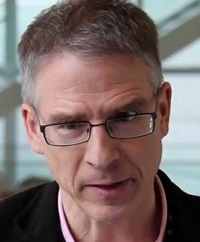 Christof Koch Christof Koch has published more than 300 scientific papers and five books. The first book that Christof Koch published is Methods in Neuronal Modeling, which focuses on the how information is processed in the nervous systems from the level of individual ionic channels to large-scale neuronal networks. His text, The Quest for Consciousness: A Neurobiological Approach is extremely accessible and summarizes the main known biological facts that seem particularly pertinent to the mind-brain problem, particularly visual awareness. Christof Koch integrates evidence from electrophysiological data, imaging and psychophysical studies, computational models, and clinical observations into a comprehensive and integral whole. The book appeals to neuroscientists, cognitive scientists, and philosophers concerned with the scientific study of consciousness. Even though most of the book is written with a pragmatic emphasis on the neurobiology of consciousness, the first chapter still provides a concise summary of some of the most prevalent philosophical approaches to consciousness. Koch's moving autobiography is Consciousness: Confessions of a Romantic Reductionist. In this book, Christof Koch focuses on questions like what links the conscious experience of pain, joy, color, and smell to bioelectrical activity in the brain? How can anything physical give rise to nonphysical, subjective, conscious states? In his career, he has centered his work on the seemingly unbridgeable gap between the physics of the brain and phenomenal experience. This book is a part scientific overview, part memoir, part futurist speculation for an empirical explanation of consciousness. Christof Koch recounts not only the birth of the modern science of consciousness but also the underlying motivation for his quest for the belief that life is meaningful. Koch describes his groundbreaking works with Francis Crick in the 1990s and 2000s on visual perception and its relation to self-reflective awareness. Christof Koch provides a rich panoply of stories drawn from modern research into the neurobiology of consciousness as well as his reflections on a variety of topics, such as the distinction between attention and awareness, the unconscious, how neurons respond to Homer Simpson, the physics and biology of free will, dogs, Der Ring des Nibelungen, sentient machines, the loss of his belief in a personal God, and sadness. Throughout it all, Koch wants to uncover the roots of awareness and what it means to be a human being. Koch's latest work is The Feeling of Life Itself. Here he argues that what is needed to answer certain key questions in philosophy and psychology is a quantitative theory that starts with experience and proceeds to an up to date and accurate model of the brain. In The Feeling of Life Itself, Christof Koch outlines such a theory that is based on Integrated Information Theory (IIT). The theory predicts that many, and perhaps all, animals experience consciousness and that it much more widespread than we ever thought possible before. Contrary to received wisdom, however, Christof Koch argues that programmable computers will not have consciousness. Even a perfect software model of the brain is not conscious. Its simulation is fake consciousness. Consciousness is not a special type of computation and it is not a clever hack. Consciousness is about being. When asked the question by Antonio Regalado (See MIT Technology Review, October 2, 2014), “If I build a perfect software model of the brain, it would never be conscious, but a specially designed machine that mimics the brain could be?” Koch gave the following reply: “Correct. This theory clearly says that a digital simulation would not be conscious, which is strikingly different from the dominant functionalist belief of 99 percent of people at MIT or philosophers like Daniel Dennett. They all say, once you simulate everything, nothing else is required, and it's going to be conscious. Although Koch is highly respected scientist, he tries to present his ideas to the public in a clear and cogent fashion. He is clearly one of those thinkers that others in the field of consciousness studies keep a close tab on, given his brilliant intellect and his willingness to explore unpopular ideas. Further Reading1. The Feeling of Life Itself: Why Consciousness Is Widespread but Can't Be Computed, The MIT Press (September 24, 2019) 2. The Quest for Consciousness: A Neurobiological Approach, Roberts and Company Publishers; 1st edition (January 1, 2004) 3. Consciousness: Confessions of a Romantic Reductionist, The MIT Press; 1 edition (March 9, 2012) 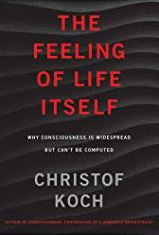 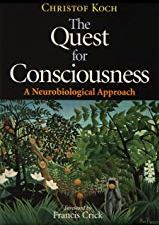 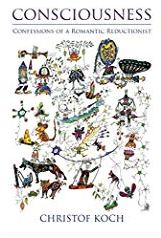 Christof Koch on Five Myths about ConsciousnessExcerpted from The Washington Post, July 26th, 2019“Consciousness” refers to any subjective experience—the delectable taste of Nutella, the sharp sting of an infected tooth, the slow passage of time when bored, the sense of vitality and anxiety just before a competitive event. In the words of the philosopher Thomas Nagel, consciousness exists in a human or other subject whenever “there is something it is like to be that organism.” The concept has inspired countless philosophical theories since antiquity and much laboratory work over the past century, but it has also given rise to many misunderstandings. Myth No. 1: Humans have a unique brain. There's a long history of scientists thinking they have identified a particular feature to explain our advanced consciousness (and planetary dominance). In a popular TED talk, the neuroscientist Suzana Herculano-Houzel argues that the human brain's distinctiveness lies in the huge number of neurons that make up the outermost layer of the organ, the cerebral cortex (or neocortex): 16 billion, out of some 86 billion total neurons. “That's the simplest explanation for our remarkable cognitive abilities,” she says. Other suppositions have included special brain regions or nerve cells found only (or primarily) in humans—spindle or von Economo neurons, for example. Or perhaps the human brain consumes more calories than the brains of other species? After close to two centuries of brain research, however, no single feature of the human brain truly stands out. We certainly do not possess the largest brain—elephants and whales trounce us. Recent research has revealed that pilot whales, a type of dolphin, have 37 billion cortical neurons, undermining Herculano-Houzel's hypothesis. And researchers have found that whales, elephants and other large-brained animals (not just great apes and humans) also have von Economo neurons. New research shows that humans and mice have about the same number of categories of brain cells. The fact is, there is no simple brain-centric explanation for why humans sit atop the cognitive hill. Myth No. 2: Science will never understand consciousness. This is a particularly pernicious myth, because it inhibits research. “I have a much easier time imagining how we understand the big bang than I have imagining how we can understand consciousness,” the eminent string theorist Ed Witten has said; it's likely to “remain a mystery,” he insists. “The Hard Problem of Consciousness”—some say insurmountable—is the phrase the philosopher David Chalmers coined to describe the immense leap required to move from understanding which brain events are linked to consciousness to how they would give rise to consciousness. But the argument that difficult science problems are unsolvable has a very poor track record. And scientists and clinicians have learned more about consciousness over the past century-plus than in all of preceding history. An entire profession, anesthesiology, is devoted to safely turning consciousness off and on again. We are getting better at detecting its presence or absence in neurologically impaired patients unable to speak or otherwise interact with their environment—by stimulating their brains using a magnetic pulse and then monitoring the echoes of the evoked electrical activity crisscrossing the neocortex. Researchers study the neuronal footprint of consciousness by presenting images or other stimuli to people in magnetic scanners and identifying which brain regions respond. These advances have not solved the hard problem, to be sure, but there is little reason for pessimism that they won't, eventually. Myth No. 3: Dreams contain hidden clues about our secret desires. Sigmund Freud called dreams “the royal road to the unconscious.” Much 20th-century thinking about dreams has been influenced by his theory that at the heart of any dream is the fulfillment of desires and wishes that are suppressed by the mind. “In psychoanalytic theory, dreams represent wish fulfillment, unconscious desires, and conflicts,” as the website GoodTherapy puts it, and are often rife with “repressed, symbolic meaning.” They have to be deciphered using free association or other methods. But modern research exploring the content of dreams of healthy subjects, as well as dreams of patients suffering from trauma, does not support this theory. William Domhoff, a research psychologist, maintains an online dream bank with more than 20,000 curated dream reports. It and other resources make clear that most of our dreams contain residue from our daily concerns and events—interrupted by seemingly random episodes either imagined or recalled and woven into the narrative tapestry. There is usually clear continuity between dream content and waking conceptions: People who are anxious have anxiety dreams; victims of trauma have flashbacks or recurrences of their traumatic experiences. Sometimes we express sexual longing for somebody—but that hardly requires decoding. By and large, dreams do not disguise our desires but rather express our concerns in a readily understandable and coherent manner. Myth No. 4: We are susceptible to subliminal messages. Subliminal advertising—which includes words or images that can't be consciously perceived—became famous in 1957, after a marketing researcher claimed to have radically boosted sales of popcorn and Coca-Cola in a movie theater by flashing the phrases “eat popcorn” and “drink Coca-Cola” on-screen for a single frame. He later admitted he'd made up the data. But interest in the concept persisted: In the book “Subliminal Seduction” (1974), author Wilson Key claimed that 99 percent of alcohol ads include subliminal messages. In 2000, Republicans were accused of trying to unconsciously manipulate voters with a TV ad that attacked the role of “bureaucrats” in an Al Gore health-care plan—and lingered ever so briefly on the letters R-A-T-S. To be sure, over the years, some studies have found evidence that unconsciously presented words and images can influence ideas and behavior, but many of those studies could not be replicated. (One influential 1970 study found that exposure to the word “Coke” increased thirst, but it fell apart when conducted again in 1989.) Although research continues, the best evidence suggests that if subliminal messages have any effects at all, they are inconsistent, small and short-lived: One 2015 study found that unconscious exposure to a brand name raised interest in that brand a bit—but also that the effect evaporated after 15 minutes. You need not worry about subliminal propaganda. As the present political moment makes clear, it is overt, conscious messages—hateful insults directed by influential people at members of minority groups, for example—that hold the real power. Myth No. 5: Near-death 'visions' are evidence of life after death. Patients revived after heart failure or other close-to-fatal episodes sometimes report having felt detached from their body, seeing a bright light or sensing that they are in the presence of the numinous. Many consider these experiences to be proof of a divine realm. Eben Alexander, in the bestseller “Proof of heaven: A Neurosurgeon's Journey Into the Afterlife,” reported, while deep in a coma, entering “the strangest, most beautiful world I'd ever seen.” Pondering the implications, he wrote: “So I was communicating directly with God? Absolutely.” Once dismissed by scientists as idiosyncratic hallucinations or derided as occult experiences, these episodes are now drawing close attention. Epidemiological surveys find that significant near-death visions are not that rare, occurring in roughly a 10th of patients who have undergone cardiac arrest. It appears that they are related to neurological events that occur when particular cortical regions are starved of oxygen critical to their function, though the precise cause is unknown. Similar intensely felt experiences occur during temporal-lobe epileptic seizures or during direct stimulation of certain regions of the exposed cortex during neurosurgery, further evidence of their biological, not spiritual, origins. Visions that people experience when near death—often devoid of religious content—appear to be attempts by the brain to continue to do its job of comprehending the world even when its own function is hampered, and when some of its perceptual and memory circuits are offline or generating spurious activity. Though we don't need to turn to supernatural explanations, it is important to study why these events leave many patients with a long-lasting sense of calm, serenity and acceptance of their eventual demise. Understanding that could lead to therapeutic breakthroughs.
MSAC PHILOSOPHY GROUP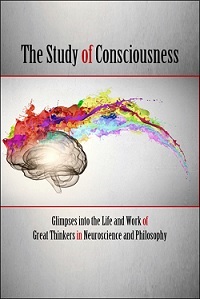
Human interest in the nature of consciousness dates far back to our ancestral past. However, it is only in the last century or so that researchers and philosophers have been able to tackle the problem in a more scientific way. This is primarily due to our increasing understanding of human physiology and how our brain functions. With the advent of ever more sophisticated technology—from fMRI scans, functional magnetic resonance imaging, to DARPA's neural engineering program, understanding neural “dust”—we are now able to not only create vivid simulations of cerebral activity but also to systematically reverse engineer the brain. Whether such empirical observations will unlock the secrets of self-reflective awareness is still open to vigorous debate. Nevertheless, the study of consciousness is now considered to be of elemental importance and has invited a large number of brilliant thinkers—from a wide range of disciplines, including mathematicians, quantum physicists, neuroscientists, and philosophers—to join in the discussions and offer their own contributions. The following essays briefly explore the life and work of pioneers in the field of consciousness studies. Included in this eclectic mix are such notables as Giulio Tononi (University of Wisconsin), Paul and Patricia Churchland (University of California, San Diego), Noam Chomsky (M.I.T.), the late Timothy Leary and Terence McKenna, and Jean Pierre Changeux (Collége de France) among others.
Comment Form is loading comments...
|